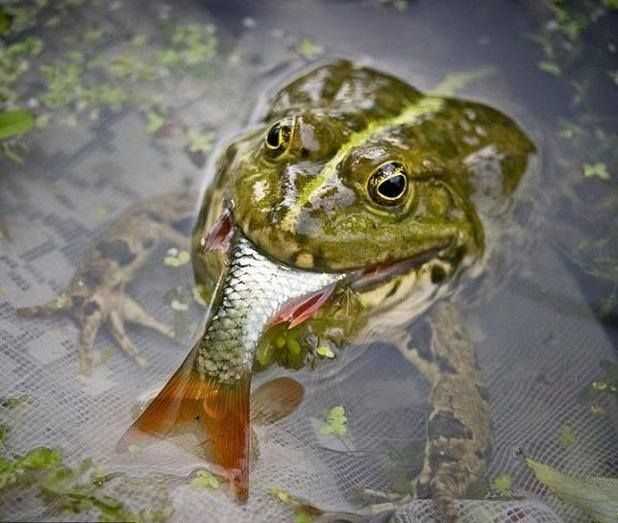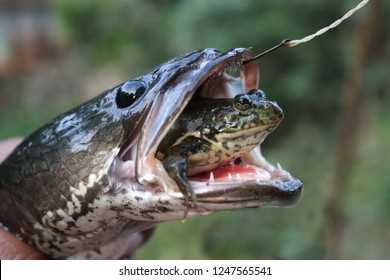
There is a popular belief that fish are predators of frogs and that they pose a significant threat to their survival. However, is this belief based on facts or is it just a myth? Let’s explore the relationship between fish and frogs to find out the truth.
While frogs may occasionally fall victim to fish predation, it is crucial to understand that frogs have developed various adaptations to avoid becoming fish food. Frogs have evolved to live in different habitats, including those with fish, and they have developed strategies to escape from their potential predators. They have unique skin coloration and patterns that help them blend in with their surroundings, making it difficult for fish to spot them. Additionally, frogs have powerful hind legs that allow them to jump quickly and escape from danger.
Another important aspect to consider is that fish and frogs often occupy different aquatic ecosystems. Frogs prefer freshwater habitats such as ponds, swamps, and marshes, while fish species can be found in different types of water bodies, including lakes, rivers, and oceans. This spatial separation between fish and frogs helps reduce the chances of interaction and predation.
Fish and Frog Interaction
Some fish species do prey on frogs, especially when they are in their larval or tadpole stage. These fish have adaptations that allow them to catch and consume frogs efficiently. They may have specialized jaw structures or teeth that enable them to grasp and swallow frogs. Additionally, some fish species are more active predators than others, actively seeking out and consuming frogs as part of their diet.
However, not all fish species prey on frogs. Some fish, especially those that feed primarily on plants or insects, may not have a strong interest in consuming frogs. These fish are less likely to interact with frogs, either due to differences in their feeding preferences or habitat preferences.
The interaction between fish and frogs can also be influenced by factors such as habitat complexity and availability of food resources. For example, in habitats with dense vegetation or structures, frogs may find refuge from fish predators, reducing the chances of predation. Additionally, if the availability of alternative prey is high, fish may be less inclined to prey on frogs.
| Fish Species | Frog Predation |
|---|---|
| Bass | Yes |
| Pike | Yes |
| Catfish | No |
Predatory Behavior of Fish
Methods of Predation
Once a fish detects a frog, it quickly moves towards it and uses its mouth to grab and consume it. Depending on the size of the fish and the frog, the entire frog may be swallowed or the fish may tear it into smaller pieces before ingestion.
Fish Species that Prey on Frogs

The exact impact of fish predation on frog populations depends on several factors, including the abundance of fish, the availability of alternative prey, and the specific habitats in which the frogs live.
Fish Species that Prey on Frogs

It is a well-known fact that fish are voracious predators, and frogs are not an exception. Many fish species have been observed preying on frogs in various aquatic habitats. The predation of fish on frogs is not limited to any specific geographical location and can be found in both freshwater and marine environments.
One of the most common fish species known to prey on frogs is the largemouth bass (Micropterus salmoides). Largemouth bass are opportunistic feeders and have a wide diet that includes small fish, crayfish, insects, and amphibians. They are particularly known for their ability to ambush their prey, making them highly effective predators of frogs.
Another fish species that preys on frogs is the northern pike (Esox lucius). Northern pike are aggressive predators that inhabit freshwater lakes and rivers. They have a broad diet that includes fish, small mammals, and amphibians like frogs. With their sharp teeth and powerful bite, they are capable of capturing and consuming frogs with ease.
The Impact of Fish Predation on Frog Populations
Frogs are an important part of aquatic ecosystems, playing key roles in maintaining the balance of the food web. However, the interaction between frogs and fish can have significant implications for frog populations. Fish predation on frogs can have both direct and indirect effects on frog populations, ultimately affecting their abundance and distribution.
Direct predation by fish is a major threat to frogs. Many fish species have a voracious appetite for frogs and will actively hunt and eat them. Frogs, especially those in their tadpole stage, are vulnerable to fish predation due to their limited swimming ability and lack of defensive mechanisms. Fish can easily detect and catch tadpoles, resulting in high mortality rates.
In addition to direct predation, the presence of fish can also have indirect effects on frog populations. Fish alter the behavior and habitat use of frogs, forcing them to modify their activities and distribution patterns. Frogs may avoid fish-infested areas, limiting their access to suitable breeding and foraging habitats. This can lead to decreased reproductive success, reduced population size, and ultimately, local extinctions of frog species.
To mitigate the negative impact of fish predation on frog populations, conservation efforts have been implemented. One approach is the removal or control of fish populations in specific habitats to create safe refuges for frogs. This can involve the physical removal of fish or the use of barriers to prevent fish from accessing frog breeding areas. Habitat restoration and creation of fish-free zones can also help maintain suitable habitats for frogs.
Coexistence of Fish and Frogs
One of the main factors that determine the coexistence of fish and frogs is the availability of suitable habitat. Fish and frogs both require specific types of habitats for survival, such as clean water, vegetation, and hiding places. In ecosystems where these conditions are met, fish and frogs are more likely to coexist.
Another important factor is the size and behavior of fish species. Larger fish species are more likely to prey on frogs, while smaller fish species may not pose a significant threat. Additionally, fish species that are more active predators, such as bass and pike, may have a stronger impact on frog populations compared to species that are less predatory.
The behavior and adaptations of frogs also play a role in their ability to coexist with fish. Frogs have evolved various mechanisms to avoid predation, such as camouflage, jumping ability, and toxin secretion. These adaptations help them avoid detection by fish and increase their chances of survival.
| Factors Affecting Fish-Frog Relationship |
|---|
| Availability of suitable habitat |
| Size and behavior of fish species |
| Behavior and adaptations of frogs |
| Interactions with other species |
Factors Affecting the Fish-Frog Relationship
Habitat
The type of habitat plays a crucial role in determining whether fish and frogs will coexist or not. Some habitats, such as ponds and lakes with abundant vegetation, provide frogs with suitable hiding places and breeding grounds, reducing the likelihood of predation by fish.
In contrast, open-water habitats like rivers, streams, and reservoirs tend to have higher fish populations, making it more challenging for frogs to avoid predation.
Fish Species
Not all fish species are predators of frogs. Some fish may have a preference for other food sources, such as insects or algae, while others may actively prey on frogs. The presence of fish species that specifically target frogs can have a significant impact on frog populations.
Frog Behavior
The behavior of frogs also plays a role in their vulnerability to fish predation. Frogs that are more active during the day and prefer open areas are more likely to encounter fish and become targets. On the other hand, frogs that are primarily nocturnal or seek shelter in vegetation have a higher chance of avoiding fish predators.
Population Dynamics
The population dynamics of both fish and frogs can affect their interaction. If fish populations increase, there may be more pressure on frog populations as a food source. Similarly, if frog populations decline or become rare in a particular habitat, fish may switch to other food sources, potentially impacting the balance of the ecosystem.
Human Activities
| Frogs | Eat | Fish |
|---|---|---|
| Common frogs | X | |
| Tree frogs | X | |
| Bullfrogs | X |
Adaptations of Frogs to Avoid Fish Predation
Frogs have developed several adaptations to avoid being eaten by fish. These adaptations help them to survive in aquatic habitats where fish are present.
Camouflage: One of the ways frogs protect themselves from fish predation is by blending in with their surroundings. Frogs have the ability to change their skin color and pattern to match the environment they are in. This makes it difficult for fish to spot them, allowing the frogs to remain hidden and avoid being eaten.
Jumping: Frogs are excellent jumpers and they use this skill to quickly escape from fish that may try to catch them. When a fish approaches, the frog can quickly leap out of harm’s way and find safety in nearby vegetation or on land. This jumping ability gives frogs an advantage in avoiding fish predation.
Warning Coloration: Some frog species have developed bright and bold colors to warn predators, including fish, that they are toxic or unpalatable. These warning colors often signal to fish that eating the frog would be a bad idea, as it could lead to illness or even death. This adaptation serves as a deterrent to fish, reducing the likelihood of predation.
Common Myths about Fish and Frog Interaction
Another myth is that fish will always eat frog eggs and tadpoles. While some fish species do feed on amphibian eggs and larvae, not all fish target them as a food source. In fact, many fish species are not adapted to eat the gelatinous egg masses laid by frogs, making them an unsuitable prey item. Additionally, some frogs have developed strategies to keep their eggs and tadpoles safe from fish predation, such as laying eggs in shallow, vegetation-rich areas or attaching them to underwater surfaces.
The Importance of Dispelling these Myths
Conservation Efforts to Protect Frogs from Fish Predation
1. Habitat Restoration
One of the most effective ways to protect frogs from fish predation is through habitat restoration. By restoring and creating suitable habitat for frogs, such as wetlands and ponds with dense vegetation, the risk of fish predation can be reduced. These habitats provide shelter and hiding places for frogs, making it harder for fish to locate and prey on them.
2. Fish Removal
In some cases, it may be necessary to remove fish populations from frog habitats to protect the frog populations. This can be achieved through various methods, such as electrofishing or trapping and relocating the fish to another suitable habitat. By reducing or eliminating fish populations, the risk of predation on frogs can be significantly reduced.
3. Predator Exclusion
Another approach to protect frogs from fish predation is by implementing predator exclusion measures. This can involve the installation of physical barriers, such as fences or nets, to prevent fish from entering frog habitats. By creating barriers that only allow frogs to enter and exit the habitat, the risk of fish predation can be minimized.
4. Education and Outreach

Education and outreach programs can play a crucial role in protecting frogs from fish predation. By raising awareness about the impact of fish predation on frog populations, the general public can be encouraged to take action and support conservation efforts. This can include promoting responsible pet ownership to prevent the release of non-native fish species into natural habitats.
